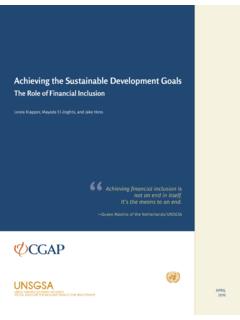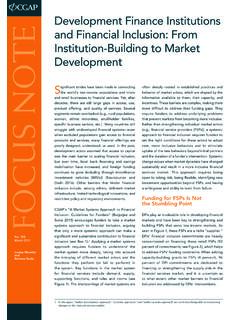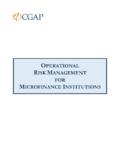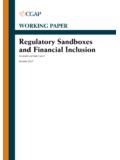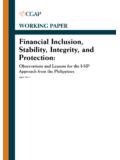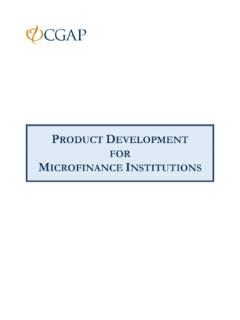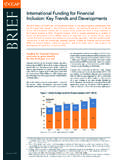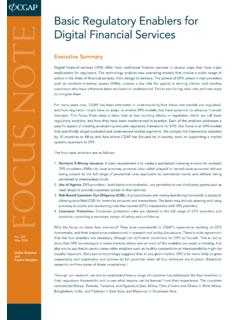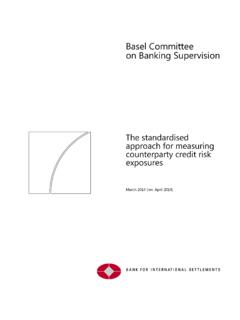Transcription of Measuring Results of Microfinance Institutions
1 Measuring Results of Microfinance Institutions Minimum Indicators That Donors and Investors Should TrackA Technical GuideRichard Rosenberg June 2009 2009, Consultative Group to Assist the Poor/The World BankAll rights Group to Assist the Poor1818 H Street, , Washington, DC 20433 USAI nternet: : +1 202 473 9594 ContentsIntroduction 11. Outreach: Breadth (number of clients served) 32. Outreach: Depth (client poverty level) 43. Loan repayment (portfolio quality) 54. Financial sustainability (profitability) 85. Efficiency 11A final note 12 Summary 14 Annex A: Indicators for community-managed loan funds and other noninstitutional microcredit 15 Annex B: Calculation Examples 17 Annex C: Subsidy Dependence Index 21 Annex D: Select Bibliography 23 Annex E: Indicator Definitions and Equations 25ivAcknowledgmentsThe author is grateful to Till Bruett, Jasmina Glisovic-Mezieres, and Alexia Latortue, all of whom contributed substantially to this unding agencies Microfinance interventions produce better Results when design, reporting, and monitoring focus explicitly on key measures of performance that are measured and reported regularly.
2 The more transparent the Results , the more likely funders are to learn from successes and failures, and to take corrective actions when needed. Unfortunately, many projects that support retail Microfinance providers fail to include such measurement. This is especially true of programs that channel support indirectly (through networks or wholesale apex facili-ties, for example) and credit components of nonfinancial programs (such as revolving funds lodged in social projects).This Technical Guide is written for funding agency staff who design or monitor projects that finance Microfinance Institutions (MFIs) or commu-nity-managed loan funds (CMLFs). The main text covers indicators for MFIs; CMLF indicators are treated in an Annex indicators?This Guide offers basic tools to measure performance in a few critical areas:1.
3 Breadth of outreach How many clients are being served?2. Depth of outreach How poor are the clients?3. Loan repayment (portfolio quality) How well is the lender collecting its loans?4. Financial sustainability (profitability) Is the MFI profitable enough to maintain and expand its services without continued injections of subsidies?5. Efficiency How well does the MFI control its operating costs?This list has been kept short, and the treatment of indicators as basic as possible, to make this Guide useful for nonspecialists. These are the core indicators recommended in Good Practice Guidelines for Funders of Microfinance (CGAP 2006), based on decades of experience working with retail MFIs. There is widespread consensus on the three indicators of financial Measuring Results of Microfinance Instituions2performance portfolio quality, financial sustainability, and efficiency that occupy most of the discussion in this , virtually all noncommercial funders of Microfinance see finan-cial performance not as an end in itself but as a means to achieving social Results , namely welfare improvements for clients.
4 Two of the indicators breadth and depth of outreach capture social dimensions of performance, but they fall far short of tracking ultimate client benefits. Funders that want to monitor the social performance of their projects will usually want to track more than just outreach. Several groups are working to propose and test additional indicators that measure social performance more directly. But there is as yet no consensus on any small subset of those social indicators that should be reported by every should the indicators be used? The five indicators suggested here do not capture all relevant aspects of MFI performance. Most funding agency project officers and investment analysts, and certainly all MFI managers, will want to monitor a longer list of indi-cators for any given And there are important dimensions, such as governance quality, that simply cannot be quantified.
5 The performance areas discussed here represent a minimum that should be treated in all project designs (reporting past performance of institu-tions that are expected to participate, and ensuring that systems are in place to measure these indicators during the project) monitored and reported during implementation included in all other appraisals or evaluations of existing Institutions tracked regularly in agency-wide performance-monitoring databasesFunders provide much of their support to MFIs indirectly, through various wholesale facilities, including international networks, national apex funds, and other investment vehicles. To monitor whether such a wholesale facility is achieving its objectives, a funder needs to track the performance of the MFIs that the facility is financing. This list of core indicators should be tracked in all cases where a funder s resources are used to support retail MFI operations, whether directly or indicators apply to retail Microfinance providers that lend directly to end-borrowers.
6 They are also useful for projects supporting savings and loan cooperatives that serve poor or low-income clients, even if the coopera-1 See Annex D for further information on social See, for example, CGAP (2001) and ACT/SEEP (2005). 3 This would include any substantial financing of MFIs portfolios or core operations, as well as projects where substantial amounts of resources are used for technical support to specific Results of Microfinance Instituions3tives would not characterize themselves as Microfinance Institutions . This Technical Guide does not cover projects supporting market infrastructure or policy development, since there is no consensus so far about common A addresses indicators for community-managed revolving funds and other forms of microcredit that do not pass through formal MFIs that have paid staff.
7 Annex B provides calculation examples. Annex C is a brief discussion of the Subsidy Dependence Index, one of the recommended measures of sustainability. Annex D lists useful references. Annex E reca-pitulates the definitions or equations for all the indicators1. Outreach: Breadth (number of clients served)Indicator The best measurement of outreach is straightforward: The number of clients or accounts that are active at a given point in timeThe number of active clients includes borrowers, depositors, and other clients who are currently accessing any financial services. This indicator is more useful than the cumulative number of loans made or clients served during a Among other distortions, cumulative numbers make an MFI that offers short-term loans look better than one that provides longer term loans, even though the latter may be more valuable for borrowers.
8 To reflect actual service delivery, membership-based organizations should report on active clients, not just the number of members: members may be inactive for long periods, especially in financial single client may hold multiple accounts. All MFI information systems should be able to track numbers of active accounts, but some are not able to eliminate double-counting so as to arrive at the number of individual clients. In such cases, numbers of accounts is an acceptable Almost all Microfinance interventions aim ultimately at expanding the number of clients being served. But rapid expansion sometimes proves to be unsustainable, especially during an MFI s early years when it needs to focus on designing its products and building its systems. It is usually counter-productive for funders to pressure MFIs for rapid An exception is payment or other money transfer services, for which number of transactions is a more meaningful Results of Microfinance Instituions42.
9 Outreach: Depth (client poverty level)Indicator Many, though not all, Microfinance projects have poverty reduction as an explicit objective, and are thus expected to reach poor clients. For such proj-ects, there are various techniques for Measuring client poverty levels, some quite expensive and others simpler, but as yet there is no widespread agree-ment on any one of them. If the project does not use a more sophisticated indicator, it should at a minimum report the following very rough proxy for the poverty level of loan or savings clients at a point in time:This indicator is often shown as a percentage of per capita Gross National Income (GNI):The average outstanding balance includes only loan amounts that clients have not yet repaid, or savings that clients have not withdrawn. This point-of-time number should not be confused with total amounts loaned or deposited during the reporting period, or with the average initial amount of the loans in the Expressing average balance as a percentage of GNI per capita allows for a comparison of how deeply MFIs from different countries reach down in their own national income Some regard an average outstanding loan balance below 20 percent of per capita GNI as a rough indication that clients are very poor.
10 The Microfinance Information Exchange (MIX) clas-sifies lenders as being MFIs if their average outstanding loan balance is not above 250 percent of per capita outstanding balance is roughly related to client poverty, because better off clients tend to be uninterested in smaller loans or deposit accounts. But the correlation between account balances and poverty is 5 GNI comprises the total value of goods and services produced within a country ( , its Gross Domestic Product or GDP), together with its income received from other countries (notably interest and dividends), less similar payments made to other countries. The World Bank calculates GNI annually. For any country it can be found at in the data and research section or in the environment section. Gross amount of loans or savings outstandingNumber of active clients or accountsAverage Outstanding Balance = Average outstanding loans or savings balance per clientGNI per capitaMeasuring Results of Microfinance Instituions5far from precise.

